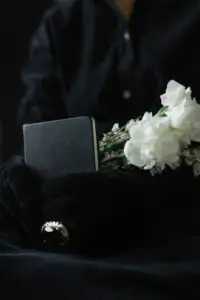Contents
What to Wear to a Funeral?
Losing a loved one is never easy, and attending a funeral can be a somber and emotional experience. In such moments, one of the last things on your mind might be what to wear. But believe it or not, your choice of attire for a funeral speaks volumes. It’s a way to show your respect for the departed and their grieving family. So, what do you wear to a funeral? This comprehensive guide will help you navigate the tricky waters of funeral attire, whether you’re a family member, a friend, or just paying your respects.
Understanding the Funeral Dress Code
Traditional Funeral Dress Codes
Black Attire: History and Symbolism
Traditionally, black has been the color of mourning. It symbolizes respect and solemnity. Wearing black is a way of saying, “I am here to honor and support you in your time of loss.” You don’t need to be draped in black from head to toe, but incorporating black into your outfit is a sign of empathy.
For example, consider the case of John, who recently attended the funeral of his close friend’s father. He chose to wear a well-fitted black suit and a white dress shirt with a black tie. This classic combination conveyed not only his respect for the deceased but also his support for his grieving friend.
Dark, Muted Colors: Alternatives to Black
While black is the go-to choice, dark and muted colors like gray, navy, or deep purple can also be suitable. These colors convey the same sense of respect and seriousness. Think of them as gentle alternatives if an all-black outfit feels too somber for you.
Take Sarah, for example, who attended her grandmother’s funeral. Knowing her grandmother’s love for vibrant colors, she opted for a dark navy dress, respecting the tradition but also adding a personal touch to honor her grandma’s spirit.
Contemporary Funeral Dress Codes
Funeral attire norms have evolved over time. Nowadays, wearing black isn’t an absolute necessity. Many contemporary funerals accept a broader range of colors, reflecting the deceased’s life and personality. But always remain sensitive to the family’s wishes and the specific cultural or religious customs in play.
For instance, a multicultural gathering might embrace various colors representing different aspects of the deceased’s life. In such cases, wearing a piece of clothing in a color significant to the person being remembered can be a beautiful gesture.
Factors Influencing Funeral Attire Choices
When selecting your funeral attire, there are several factors to consider.
Relationship to the Deceased
Immediate Family Members
If you’re a close family member, such as a spouse, child, or parent of the deceased, it’s generally expected that you’ll wear a more formal and traditional outfit. This could include a black suit or dress.
Let’s take the example of Mary, who was attending her father’s funeral. She chose a black dress with a tasteful black hat and veil. Her outfit not only reflected her deep sorrow but also showed her commitment to honoring her father’s memory.
Friends and Acquaintances
For friends and acquaintances, you have a bit more flexibility. You can lean towards contemporary and less formal options while still maintaining an air of respect.
Consider the case of Mark, who was attending the funeral of a coworker’s parent. He decided on a dark gray suit, which struck a balance between paying his respects and not overdressing for the occasion. His choice respected the memory of his coworker’s parent while also feeling comfortable and genuine to his own style.
Cultural and Religious Considerations
It’s important to be aware of the specific customs associated with the deceased’s culture or religion. Different faiths have distinct requirements for funeral attire. For instance, in some cultures, white is a symbol of mourning, while in others, it represents purity and celebration. Understanding these nuances can help you avoid unintentional disrespect.
For instance, at a Hindu funeral, wearing white is considered appropriate to symbolize purity and spirituality. However, wearing bright red, associated with happiness in Hindu culture, would be highly inappropriate and considered disrespectful.
Season and Climate
Consider the time of year and the climate when choosing your outfit. For example, lightweight fabrics and shorter sleeves are appropriate for a summer funeral, while you might opt for thicker, warmer clothing in colder seasons.
Imagine attending a winter funeral in a region with freezing temperatures. In such cases, wearing a heavy, dark-colored coat and a black scarf can help you stay warm while adhering to the respectful funeral attire guidelines.
Men’s Funeral Attire
Suits and Formal Wear
The Importance of a Well-Fitted Suit
If you’re a man attending a funeral, a well-fitted suit is often the best choice. It exudes respect and formality. Make sure your suit is clean and pressed, and that it fits you comfortably.
Consider the case of David, who attended the funeral of his best friend’s grandfather. He chose a well-fitted charcoal gray suit that emphasized his commitment to honoring the memory of someone who had been like a second grandfather to him.
Appropriate Shirt and Tie Choices
For the shirt and tie, go for muted and somber colors. A white dress shirt paired with a black or dark-colored tie is a classic and respectful combination.
Imagine Mike, who was attending a funeral for a distant relative. He decided to wear a black suit with a white dress shirt and a dark gray tie. This combination was both classic and appropriate, sending a message of condolence and respect.
Business Casual Options
If a full suit feels too formal, business casual attire is a suitable alternative. Slacks and a blazer with a collared shirt can strike the right balance between respect and comfort.
A great example is Ben, who was attending the funeral of a work colleague. He chose to wear a dark navy blazer with gray slacks and a white shirt. His choice was respectful and not overly formal, which was fitting for the occasion and the nature of their relationship.
Footwear and Accessories
Your choice of footwear and accessories matters too. Opt for polished and conservative shoes. Keep accessories minimal; a tasteful tie or pocket square is usually enough.
Consider John, who decided to wear a black suit to his friend’s funeral. He completed his look with black, well-polished Oxfords and a simple black tie. His choice was respectful and understated, letting the focus remain on the departed.
Women’s Funeral Attire
Dresses and Suits
Appropriate Length and Style
For women, a dress or a suit is often the most suitable choice. Ensure the length is modest and that the style is not overly flashy. It’s not a time to showcase the latest fashion trends.
Think about Rachel, who was attending the funeral of her great aunt. She chose to wear a knee-length black dress with a modest neckline. Her outfit was not only respectful but also allowed her to move comfortably during the service and offer her condolences to family members.
Modesty and Neckline Considerations
Choose a dress or suit with a modest neckline. Avoid plunging necklines or high slits, as it’s crucial to maintain a sense of decorum.
Consider the example of Emily, who attended the funeral of a close friend’s sister. She opted for a black knee-length dress with a high neckline. Her choice was both respectful and modest, allowing her to focus on offering support to her grieving friend.
Skirts and Blouses
If you prefer separates, consider a skirt and blouse. Coordinate the pieces, making sure the overall look is respectful and not overly attention-grabbing.
Imagine Lily, who attended a co-worker’s father’s funeral. She chose to wear a black knee-length skirt paired with a gray blouse. Her outfit was well-coordinated and respectful, allowing her to pay her respects without drawing unnecessary attention to herself.
Footwear and Accessories
Closed-toe shoes with a modest heel are a good choice. Minimal and understated jewelry complements the overall tone of respect.
Let’s take the example of Ava, who attended the funeral of her neighbor. She wore black flats and minimal jewelry, consisting of a simple necklace and stud earrings. Her choice was respectful and understated, allowing her to offer condolences without any distractions.
What Not to Wear
In the context of a funeral, some attire is best avoided.
Inappropriate Attire
Stay away from bright and flashy colors. This is not the place to showcase your vibrant personality. Choose subdued hues that reflect the solemnity of the occasion.
Imagine attending a funeral and seeing someone in a bright red outfit. This would be considered highly inappropriate and could distract from the somber mood of the event.
T-shirts, Slogans, and Graphic Prints
Avoid clothing with slogans or graphic prints. The focus should be on paying respects, not making a fashion statement.
For example, someone attending a funeral in a t-shirt with a funny slogan would likely be seen as disrespectful and inconsiderate of the gravity of the situation.
Distasteful Accessories and Jewelry
Leave behind any flashy or excessive jewelry. Keep accessories simple and respectful.
Imagine someone wearing extravagant, flashy jewelry to a funeral. This would not only be out of place but could also come across as insensitive and self-centered.
Grooming and Personal Hygiene
Grooming is an essential aspect of funeral attire.
Cleanliness and Personal Grooming
Make sure your clothing is clean and well-maintained. Pay attention to personal grooming, and keep your hair neat and tidy.
Consider the case of Susan, who attended the funeral of her best friend’s mother. She ensured that her black dress was freshly laundered, and she had her hair neatly styled. Her overall appearance conveyed respect for the occasion and the family.
Perfume and Cologne Considerations
While it’s important to be clean, go easy on the perfume or cologne. Some attendees may have allergies or sensitivities.
Imagine attending a funeral and sitting next to someone with an overpowering scent. This could be distracting and uncomfortable for those around you. It’s best to opt for a subtle, non-overwhelming fragrance.
Hair and Makeup Guidelines
Your hair and makeup should be understated. Avoid dramatic or flamboyant looks; this is a time for subtlety.
For instance, at a funeral, excessive makeup, bold lipstick, or intricate hairstyles may draw attention away from the purpose of the gathering. It’s best to keep your look simple and unobtrusive.
Dressing Children for a Funeral
When attending a funeral with children, consider their attire as well.
Appropriate Attire for Children
Dress children in clean, modest, and age-appropriate clothing. Dark colors are suitable for children too.
Imagine a family attending a funeral with young children. The children are dressed in simple, dark-colored outfits to maintain the respectful tone of the occasion.
Teaching Children About the Occasion
It’s essential to explain to children the significance of the event and the need for respectful attire. This can be a valuable life lesson about empathy and respect.
Parents can take this opportunity to teach their children about the importance of honoring someone’s memory and offering support to grieving friends or family. It’s a chance to instill empathy and understanding in the younger generation.
Practical Tips
When preparing for a funeral, here are some practical tips to keep in mind:
Planning and Preparing in Advance
Select your funeral attire well in advance to avoid last-minute stress. Ensure everything is clean, ironed, and ready to wear.
Imagine waking up on the day of the funeral and realizing that your black suit is wrinkled and in need of ironing. Planning and preparing your outfit in advance can save you from this kind of last-minute wardrobe stress.
Having a Backup Outfit
Murphy’s Law has a way of showing up at the most inconvenient times. Having a backup outfit ready can save you from a last-minute wardrobe malfunction.
Consider a scenario where you accidentally spill coffee on your funeral attire just hours before the service. Having a backup outfit can be a lifesaver in such situations, ensuring you can still attend the funeral respectfully.
Bringing Tissues and Essentials
Pack some tissues or a handkerchief in your pocket or bag. Funerals can be emotional, and having these essentials on hand is thoughtful.
Imagine sitting through a touching eulogy and finding yourself in need of a tissue. Having one readily available can prevent you from becoming a distraction during the service.
Conclusion
Choosing the right attire for a funeral is a way to convey your respect and support to the grieving family and to honor the memory of the departed. Whether you opt for traditional black or contemporary muted colors, remember that your clothing speaks volumes. It’s a small, yet significant, way to show your empathy and compassion during a difficult time. So, next time you’re faced with the question, “What do you wear to a funeral?” you’ll be well-prepared to make a thoughtful and respectful choice. Ultimately, funeral attire is a way of expressing solidarity and empathy during the grieving process.









